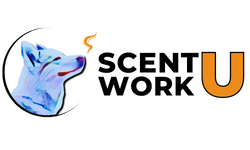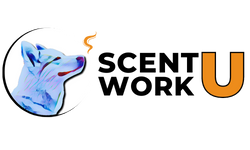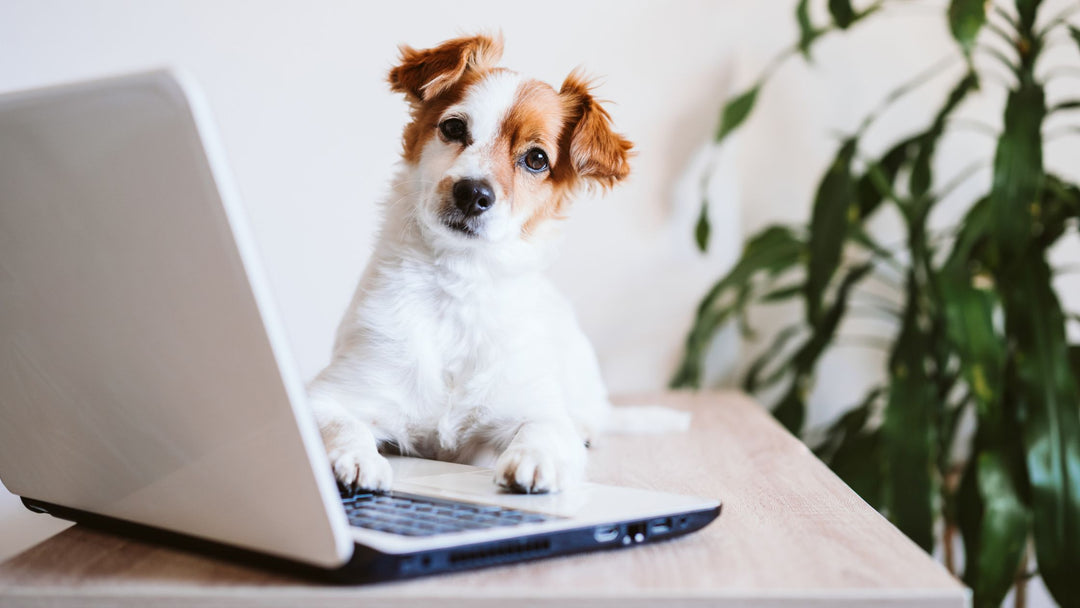Allow Your Dog Time to Learn

One the common themes I noticed teaching in-person group dog training classes was how hard it was for handlers to allow their dogs the time necessary to learn. As in give them time to truly work out a given problem.
This pattern was not solely relegated to Scent Work, it was something I noticed across the board. Handlers rushing in either to help the dog or, worst still, getting horrendously frustrated with the dog for not coming up with the answer sooner. Both approaches are detrimental to all aspects of dog training, but can be devastating when we are talking about Scent Work.
Learning Takes Time
I know this sounds obvious but is SUPER common for people to forget this simple truth when they are working with their dogs.
As humans, we are so focused on the end result that we don't realize how much time it may take for our dogs to figure out the answer to a given question. An answer, by the way, we already know.
Let me give you a human example to help illustrate what I mean: you are playing charades with a group of friends. You are miming something to them. You know the answer. They do not. How frustrating is it to you when their guesses are no where near where they need to be? What do people usually do in this situation? They mime with more force, increasingly exaggerating their movements and clearly looking flustered and annoyed. They will clench their jaws, eyes held wide, when they are not rolling into their back of their head out of frustration, all the while clearly illustrating how stupid they think their friends must be for not figuring this out. Not a whole lot of fun for anyone involved yet people still do this sort thing. It is understood that the game has some stress baked into it and there are no long-held hard feelings...most of the time.
What is the root cause of all this angst? The person miming knows the answer and thinks what they are doing is super clear (it is to them) while their teammates do NOT know the answer and the erratic motions of the person miming are making absolutely no sense to them whatsoever. You then add in the time crunch of, "your turn is almost over" and the social pressure of points and so on and you have yourself a pressure cooker of failure waiting to explode.
"Sigh. Santos, what on earth does this have to do with Scent Work?"
When we are designing training exercises for our dogs, such as an opportunity to introduce them to a particular type of odor problem, the same types of issues are there: we know the answer, how we are presenting the solution to the problem makes perfect sense to us, we will put an arbitrary time limit onto our dogs to get the answer and we will get stressed and flummoxed when the dog doesn't figure it out, all the while putting undue pressure on the dog.
"Oh..."
Yeah, not good.
Luckily, there is a solution to this.
The first is to recognize that learning does indeed take time. However, this is not some universal thing. You cannot say, "It will take all dogs 3 minutes to sort out what a corner hide odor problem looks like and how to solve it." That is absurd. Learning is an individual experience, affected by the dogs own training background, their innate strengths and weaknesses as well as how that particular exercise was set-up and so on.
"But how do I know if I am giving my dog enough time?"
That leads us to second part of the solution. Just breathe.
"Huh?"
When you are training your dog, simply breathe and give them as much time as they need to work out the problem. It could be a 30 seconds it could be 15 minutes, but as long as they are working and not stressing out or shutting down, let-them-work-it-out.
Training is basically learning opportunities. The more you can take a step back and grant the dog the time and space to get to the solution, the better it is.
Answer Must Always be Attainable
I am not, however, advocating that you throw your dog into the deep-end of the pool. They must have the skills and background to actually solve the problem. You wouldn't expect your three year-old toddler to figure out a quantum mechanics physics problem. In the same vein, you shouldn't expect your dog to solve a super complicated odor puzzle when they are brand new to that concept.
"UGH! How am I supposed to introduce them to these concept then?!"
Don't fret, I have a suggestion for you.
Introduce new odor puzzles individually first. For instance, if your dog is solid on finding target odors in a variety of search elements and now you want to work on really challenging elevation (3' and above), then set-up a search area where there is only one hide in the space and it is that elevated hide.
Consider where your start line is going to be.
Consider what the airflow will be (if indoors, will HVAC be on or off, windows open or closed?
If outdoors, which way is the wind going? To or away from the start line?).
Look at how the search area itself is designed and how that will affect the odor picture (are there areas the odor will pool or collect and will this stump the dog, etc.).
Have a good idea of how your dog MAY work out this problem. Then, allow for them to do so. Step back and really grant them the time and space to sort this out.
Feel a need to step in? Take a breath instead and just wait. There is one hide. You were certain to not over-face your dog. You are watching them for signs of stress. Just-wait.
When they are successful, get in there and reward them like never before. They just had a eureka moment, reward them as such!
I would then recommend doing an easy recovery search using a familiar set-up that is super straightforward for the dog (ex. a single paired odor box out in the middle of the room). Throw a big party for the dog and then plan to do a different set-up on another day.
This second set-up you can warm the dog up using the same learning exercise you did the first time. Dog comes up, in our example they sort out the elevated hide problem, and you reward. Good dog! Now for your second repetition, you will weave this problem into a more involved search area. This can include adding other hides to the mix (which should be DIFFERENT odor puzzles and I would argue odor puzzles that are more familiar to the dog) or changing other factors: where the start line is, controllable air flow (opening/closing windows, turning HVAC on/off, turning fans on/off, etc), adding items to the search area, etc. Run your dog and once again just breathe. Allow them the time to work this out. When they are successful, reward, reward, reward.
For myself, personally, I would tend to follow this up with a recovery search then a big party and call it a day.
The point being, you can break up how you introduce these new concepts to your dog so you are still setting them up for success while granting them the time and space to learn. There is no need for you to direct the entire search or over-face your dog to the point where they are stressing out or becoming disgusted with the game.
Don't Leave Your Dog Hanging
Now, as with all things dog training, everything depends on the individual dog you are working with and the individual training session you are working within.
In other words, you may very well have to step in to assist your dog somewhat in a given search. Your goal is to NOT have to do this, but if you notice your dog spiraling out of control where they are falling apart, do-something. Anything. Even if that means taking them out of the search area - no punishment, just simply a, "Nice try, let's take a break for a minute" - making an adjustment TO the search area and running them again. But please, for the sake of your dog, do not force them to shutdown. That should never, ever be our goal.
We all make mistakes in how we set-up our exercises. Odor is complicated. There are a lot of factors involved. Our dogs are also not robots. They may simply be off one day. It is our responsibility, however, to notice when things are going awry and to step in to fix it. There IS a big difference between asking your dog to stretch themselves mentally and capability-wise to sort out a problem and setting them up for failure. In my opinion, the second option should never BE an option.
Trialing and Training are Two Different Things
Once again, I am sure this seems super obvious to some, but is alarmingly common for people to conflate the two.
Here is a quick and dirty distinction between training and trialing:
Training is when your dog should be learning and mastering skills.
Trialing is when you are testing the dogs mastery of such skills.
It seems slight, but this distinction is crucially important for you to grasp.
Your dog should be granted the time and space to learn and truly master their skills when they are training. Otherwise, if you simply assume they have mastered a given skill set when they have not, this will come back to bite you when you are trialing.
However, trialing cannot and should not replace training. Your dog needs TRAINING to be successful when they are TRIALING...not the other way around.
In Closing...
While the allure may exist for you to rush the process or even step in to help when you are training your dog, try with all of your might to resist this urge. Breathe instead. Grant your dog the time and space to truly understand the problem that has been posed to them. Give them the opportunity to reach their own conclusion. Allow them to develop these skills. Once they have mastered them, then showcase those very skills in a trial, confident they have what it takes to do well.
So, what are you doing to ensure that your dog has the proper opportunity to learn? How are you designing your exercises and searches to help promote learning and not frustration? How are avoiding trick questions and instead keeping the questions posed to your dog fair and with attainable answers?
Author: Dianna L. Santos, KPA-CTP, CPDT-KA, CNWI
Dianna has been training dogs professionally since 2011. She has done everything from teaching group training classes and private lessons, to specializing in working with fearful, reactive and aggressive dogs, to being a trial official and competition organization staff member.
Following a serious neck and back injury, Dianna was forced to retire from in-person dog training. But she was not ready to give up her passion! So, she created Pet Dog U, Dog Sport University and Scent Work University to provide outstanding online dog training to as many dog handlers, owners and trainers possible…regardless of where they live! Dianna is incredibly grateful to the amazingly talented group of instructors who have joined PDU, DSU and SWU and she looks forward to the continued growth of PDU, DSU and SWU and increased learning opportunities all of these online dog training platforms can provide.
In June 2021, Dianna and her business partner, Sean McMurray launched Cyber Scent Work, Inc., an organization that operates in the gray space between training and trialing in Scent Work. With Cyber Scent Work, Inc., handlers have the opportunity to earn Qs, titles and ribbons while also receiving helpful training advice regardless of whether they qualify or not! Be sure to check out Cyber Scent Work, Inc., you will be happy you did!
Join Our Newsletter
Stay up to date with all the happenings at Scent Work University, including the release of new online courses, seminars, webinars, eBooks and receive exclusive promotions and discounts!


